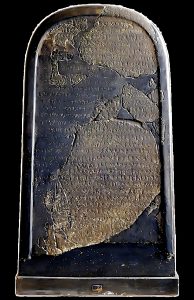The Moabite Stone, also known as the Mesha Stele, is a large slab of basalt that has provided linguists and historians with the most significant source of the Moabite language to date. The stele was discovered in fragments in 1868, about 15 miles east of the Dead Sea, and is now housed in the Louvre Museum in Paris. Despite its discovery over a century ago, it wasn’t until recently that scholars have been able to confirm with a high degree of certainty that the slab contains references to King David.
The Mesha Stele features a detailed account of King Mesha of Moab’s battle with Israel. The description in the stele corresponds, albeit loosely, with a similar account in 2 Kings chapter 3. Although the text contains references to the Israelite god, it also features allusions to the “House of David” and the “Altar of David.” Previously, scholars were unsure about how to interpret these references to King David.
The Moabite phrase “House of David” is composed of five letters: bt dwd. The first and fourth letters were already clear, but the other three were not. Recently, researchers André Lemaire and Jean-Philippe Delorme re-examined the evidence and were able to uncover the remaining letters through a method called Reflectance Transformation Imaging. This technique involved taking new digital photographs of the restored stele and the paper squeeze and combining them to create a precise, three-dimensional digital rendering of the piece. By using this method, the researchers were able to see previously hidden, faint, or worn incisions that revealed the letters taw, dalet, and dalet.
The new findings provide compelling evidence that the Mesha Stele contains explicit references to King David. This discovery is significant not only for biblical studies but also for historical and linguistic research.
More About the Moabite Stone:
Moabite Stone
The Moabite Stone, also known as the Mesha Stele, is a large slab of basalt that was discovered in Jordan in 1868 by a German missionary named Frederick Augustus Klein. The stone dates back to the 9th century BCE and is covered in an inscription that provides valuable insights into the history and culture of the ancient kingdom of Moab.
The Moabite Stone is over four feet tall and is inscribed with about 1,000 lines of text in the Moabite language, which is a dialect of Canaanite. The text describes the reign of King Mesha of Moab, who successfully rebelled against the Israelites and restored the kingdom of Moab.
The Moabite Stone is significant for several reasons. It is one of the most important archaeological finds of the 19th century and has provided scholars with valuable insights into the history and culture of the ancient Near East. Additionally, it is one of the few sources of information on the Moabite language, which was spoken in the ancient kingdom of Moab.
 The Moabite Stone also provides insights into the relationship between the Moabites and the Israelites. The text describes King Mesha’s rebellion against the Israelites and contains references to the Israelite god, as well as the “House of David,” which was the dynasty that ruled the kingdom of Judah in the southern part of Israel.
The Moabite Stone also provides insights into the relationship between the Moabites and the Israelites. The text describes King Mesha’s rebellion against the Israelites and contains references to the Israelite god, as well as the “House of David,” which was the dynasty that ruled the kingdom of Judah in the southern part of Israel.
Recent discoveries related to the Moabite Stone have further enhanced our understanding of this important historical document. In 2018, researchers from the Louvre Museum used a technique called Reflectance Transformation Imaging to uncover previously hidden inscriptions on the stone. This method involves taking digital photographs of the stone from different angles and combining them to create a precise, three-dimensional digital rendering of the piece.
In conclusion, the Moabite Stone is a fascinating and valuable artifact that provides valuable insights into the history and culture of the ancient Near East. Its discovery and decipherment have greatly contributed to our understanding of the Moabite language and its relationship to ancient Hebrew. The recent discoveries related to the Moabite Stone have opened up new avenues of research and promise to further our understanding of this important historical document.


